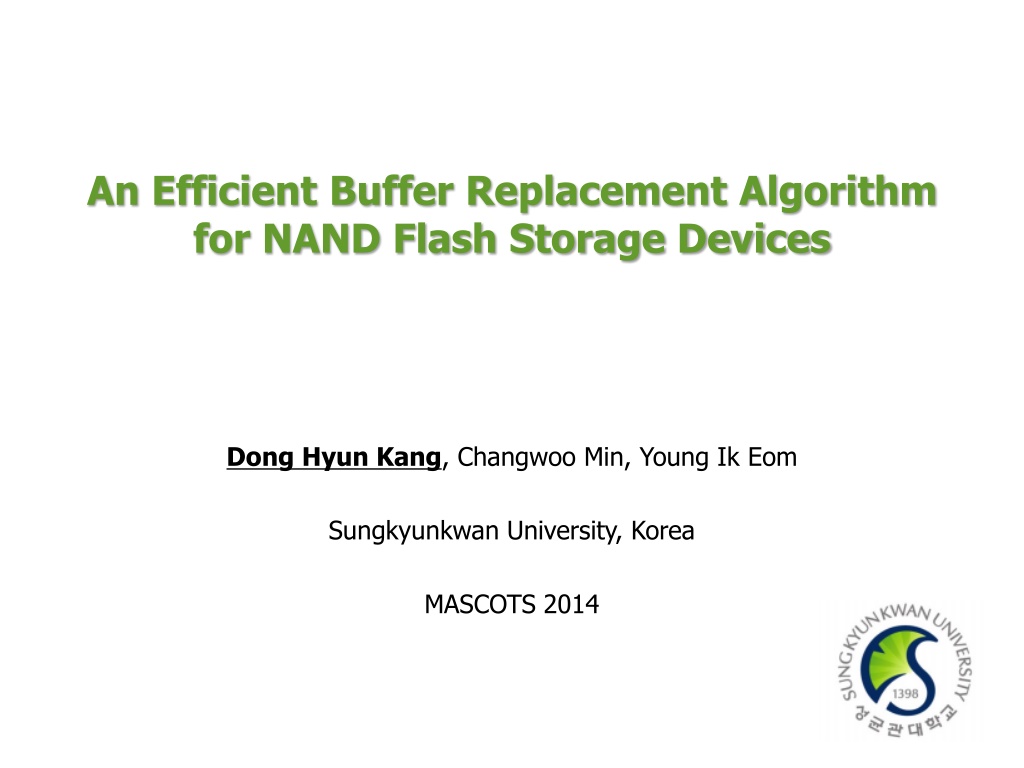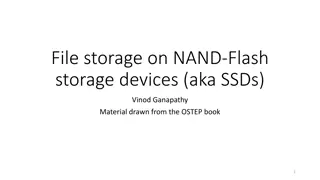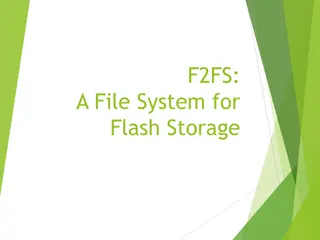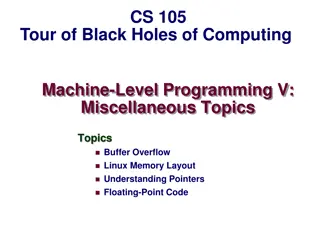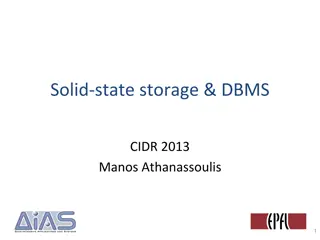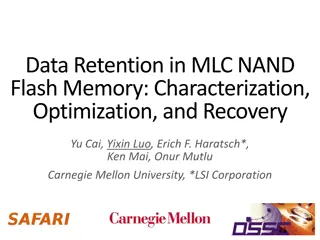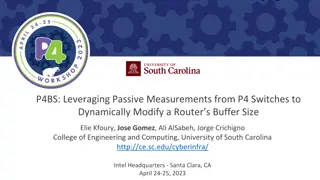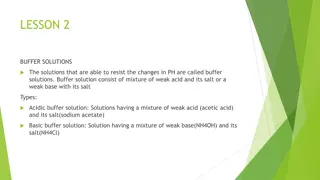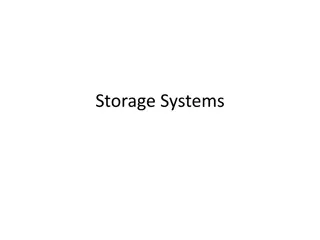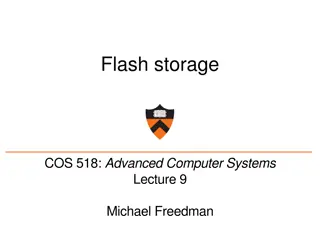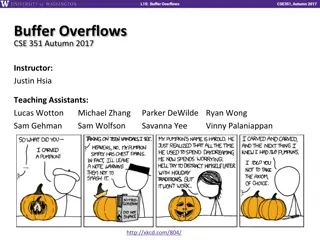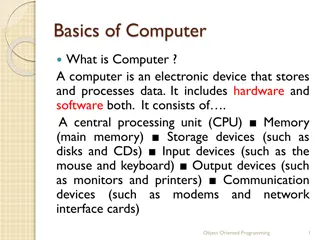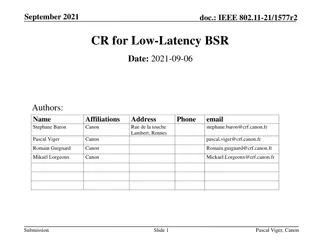Efficient Buffer Replacement Algorithms for NAND Flash Storage Devices
NAND flash storage devices are increasingly replacing traditional HDDs in modern computing systems due to their technical advantages such as low latency, low power consumption, and shock resistance. However, as flash density increases, challenges like decreased lifetimes due to random writes persist. Buffer replacement algorithms play a crucial role in transforming I/O requests for storage devices and mitigating issues like hidden writes. Flash-friendly write patterns and algorithms like TS-CLOCK aim to optimize performance and enhance the longevity of NAND flash storage devices.
Download Presentation

Please find below an Image/Link to download the presentation.
The content on the website is provided AS IS for your information and personal use only. It may not be sold, licensed, or shared on other websites without obtaining consent from the author. Download presentation by click this link. If you encounter any issues during the download, it is possible that the publisher has removed the file from their server.
E N D
Presentation Transcript
An Efficient Buffer Replacement Algorithm for NAND Flash Storage Devices Dong Hyun Kang, Changwoo Min, Young Ik Eom Sungkyunkwan University, Korea MASCOTS 2014 1
NAND Flash Storage Devices NAND flash storage devices (e.g., eMMC, microSD card, and SSD) are rapidly replacing hard disk drives (HDDs) in modern computing systems Mobile devices, laptops, and servers Technical merits No mechanical parts Low access latency Low power consumption Shock resistance Potentially uniform random access time 2
Two Remaining Problems As flash density increase, the lifetime rapidly decreases Single-level Cell (SLC): 100K ~ 1M Multi-level Cell (MLC): 5K ~ 10K Triple-level Cell (TLC): 1K Random writes significantly decrease performance and lifetime Random writes are several times slower than sequential writes Random writes generate more hidden writes inside NAND flash storage devices As a result, the lifetime can be significantly reduced by random write 3
Why Buffer Replacement Algorithm Buffer Replacement algorithm It receives I/O requests directly from applications It transforms the requests into a suitable I/O request stream for storage devices. Flash-aware buffer replacement algorithms Asymmetric read & write cost Write patterns FAB : H. Jo et al. 2005 2006 2007 2008 2009 2010 2011 2012 2013 CFLRU : S.-Y Park et al. BPLRU : H. Kim et al. LRU-WSR : H. Jung et al. LB-CLOCK : B. Debnath et al. FOR : Y. Lv et al. Sp.Clock : H. Kim et al. 4
What Flash-friendly Write Are Results of FTL simulator according to block utilizations for diff erent synthetic traces If the request of the random write are same as flash block size, such write requests invalidate whole flash block inside NAND flas h storage Since all pages in a flash block are invalidated together, traces wi th 100% block utilization have an ideal WAF with no hidden writ e overhead 5
TS-CLOCK: Temporal and Spatial Locality-aware CLOCK Overview Maximize cache hit ratio TS-CLOCK extends a well-known CLOCK replacement algorithm Consider asymmetric read and write cost TS-CLOCK prefers to evict clean pages over dirty pages Minimize hidden writes inside NAND flash storage TS-CLOCK shapes evicted dirty pages to flash-friendly write patterns TS-CLOCK can improve write performance and extend lifetime of NAND flash storage devices 6
TS-CLOCK: Temporal and Spatial Locality-aware CLOCK Page management All pages are managed by the basic rules of CLOCK algorithm Dirty block tree Dirty pages are managed by dirty block trees according to their logical sector number Size of dirty block tree is set to erase block size of NAND Flash storage When a page becomes a dirty page, the page is inserted its dirty block tree P P P P P P P P P P P P P T-hand P P P P P [Dirty block 1] [Dirty block 2] P P P [Circular list] [Red-black tree] 7
TS-CLOCK: Temporal and Spatial Locality-aware CLOCK Reference count Each page maintains a reference count to give each page a different level of opportunity to stay in the buffer cache. Clean page The reference count of clean page is always set to 1(Second Chance) for clean-first eviction Dirty page The reference count of dirty page is differently set to its utilization of dirty block tree Pages belonging to small utilization dirty block stay longer in buffer cache. Utilization 0% ~ 25% 25% ~ 50% 50% ~ 75% 75% ~ 100% Chance 4 (Fifth Chance) 3 (Fourth Chance) 2 (Third Chance) 1 (Second Chance) 8
TS-CLOCK: Temporal and Spatial Locality-aware CLOCK Replacement policy If circular list is full, a victim page is selected by two hands for reclaiming a free page. Victim page selection t-hand first scans pages in a circular list and decrements its reference count by 1 for selecting a victim page Victim page eviction If a victim page is clean, it is immediately evicted from the circular list If a victim page is dirty, s-hand scans dirty pages in dirty block tree by their sector numbers until a page with reference count of 0 is found. While the s-hand scans dirty pages, it does not decrement a reference count a dirty page in dirty block tree is evicted instead of a victim page for flash- friendly write patterns A new page is inserted to the position of the t-hand 9
TS-CLOCK: Temporal and Spatial Locality-aware CLOCK Example for clean page eviction Time 1 Time 2 67 * 67 * 31 16 53 16 14 * 14 * 13 13 50 6 50 6 t-hand t-hand 65 3 65 3 66 * 66 * 68 68 23 23 s-hand Legend clean page dirty page *A reference count is zero. (a) Initial stat (b) Cache miss: Page 53 If t-hand selects a clean page as the victim page, it is evicted for a new page 10
TS-CLOCK: Temporal and Spatial Locality-aware CLOCK Example for dirty page eviction Time 3 Time 2 67 * 67 * 67 * 67 * 53 53 28 53 16 53 16 16 16 14 * 13 13 13 14 * 13 14 * 14 * 50 50 50 6 50 6 t-hand t-hand t-hand t-hand 65 6 65 6 65 3 65 3 3 3 68 23 23 66 * 68 68 68 23 23 65 65 68 68 s-hand s-hand Legend 66 * clean page s-hand 67 * 67 * dirty page *A reference count is zero. (c) Cache miss: Page 28 If t-hand selects a dirty page as the victim page, s-hand selects another dirty page in dirty block tree and the page pointed by s-hand is evicted instead of the victim page 11
Evaluation Setup Buffer replacement simulator LRU, CLOCK, Linux2Q, CFLRU, FAB, LB-CLOCK, and Sp.Clock FTL simulator Page-level FTL Hybrid FTL (FAST) Real-world workload Type Mobile Mobile Server Server Workload Video Streaming Mixed Applications File Server TPC-C Read (MB) 0.2 526.9 7252.8 1129.2 Write (MB) 1514.4 413.2 5880.1 2357.6 Write Range (MB) 266.6 133.0 14568.2 15124.4 12
Evaluation Replaying workload To measure the real performance of each replacement algorithm, we replayed read/write request in the results of each replacement algorithm on real devices with the O_DIRECT option. Native Command Queuing (NCQ) is enabled. NAND Flash storage devices Storage-A Patriot microSD card 16 GB 4 MB MLC Storage-B Adata microSD card 16 GB 4 MB MLC Storage-C Samsung SSD 120 GB 24 MB TLC Manufacturer Type Capacity Erase Block Size Flash Memory 13
Cache Hit Ratio Erase block size (4 MB) Erase block size (24 MB) 14
Elapsed Time Micro SD card Write pattern strongly affects performance on low-end NAND flash storage devices 15
Elapsed Time SSD 16
Lifetime FAST FTL Page-level FTL 17
Conclusion Random write on NAND Flash storage devices red uce both performance and lifetime We present a novel buffer replacement algorithm It extends the CLOCK algorithm to take benefits of te mporal locality It consider both asymmetric read and write cost and f lash-friendly write pattern to improve write performan ce and extend limited lifetime We show that TS-CLOCK considerably outperforms existing flash-aware replacement schemes and pro longs the lifetime of NAND flash storage devices 19
Thank you! Questions? 20
